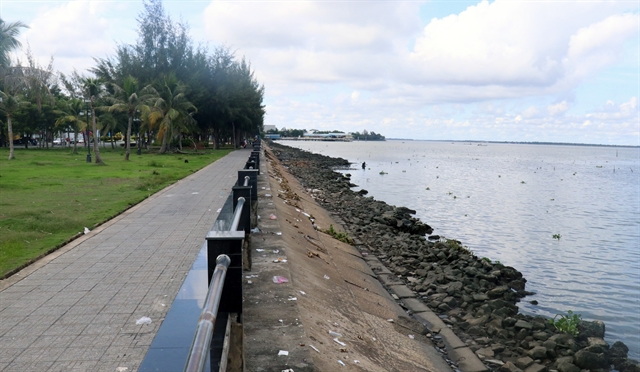 Society
Society

Authorities in the Cửu Long (Mekong) delta are speeding up works to prevent the damage caused by erosion along rivers, canals and coasts, especially in the ongoing rainy season.

|
| An embankment prevents erosion along the coast in Kiên Giang Province’s Rạch Giá City. — VNA/VNS Photo Lê Huy Hải |
HCM CITY — Authorities in the Cửu Long (Mekong) delta are speeding up works to prevent the damage caused by erosion along rivers, canals and coasts, especially in the ongoing rainy season.
In the first half of this year, the delta suffered 106 cases of river and coastal erosion that affected a total length of 4.12km, affecting agriculture and people’s lives, according to the Ministry of Agriculture and Rural Development (MARD).
Many of them occurred in Cần Thơ City and the provinces of Cà Mau, An Giang, Sóc Trăng, Vĩnh Long, Bến Tre, and Tiền Giang since June.
The building of houses and construction works near river banks and coasts and the over mining of sand from rivers are major reasons for the erosion, according to local authorities.
On Tuesday (September 7) two sections of the Cái Sắn Canal in Mỹ Thạnh Ward in An Giang Province’s Long Xuyên City were eroded, affecting 40 metres of banks.
Erosion in the area has become dangerous – there have been six instances so far that damaged houses and threatened people’s safety.
Lương Huy Khanh, head of the An Giang Steering Committee for Climate Change Response, Natural Disaster Prevention and Control, and Search and Rescue, said: “There are a large number of boats in the canal, which cause strong waves, impacting the banks.”
In the southernmost province of Cà Mau, there were 39 cases of erosion along rivers and coasts in just the first week of June that damaged 200 metres of cement roads, 22 houses and three shrimp farms.
Its western sea dyke suffered three serious cases of erosion affecting a total length of 1.7km of shore and posing a risk of breaking the 154km dyke.
Cà Mau has a 154km coast in its west and 100km in the east, and around 80 per cent of the two is eroded.
To contain it, the province is building embankments to protect its 254km of dykes.
Cần Thơ has built 10 river embankments with a total length of 18.5km and at a cost of VNĐ2.6 trillion (US$114 million) since 2018.
The central – run city is building eight more with a combined length of 21.1 km at a cost of VNĐ 2.3 trillion ($100 million).
In Kiên Giang, the province Department of Agriculture and Rural Development is inspecting dykes and embankments along rivers and coasts, and irrigation works, to repair and upgrade them since it is now the peak rainy and storm season.
Nguyễn Thanh Nhàn, deputy chairman of the Kiên Giang Province People’s Committee, said: “Besides taking measures to mitigate the impact of rains, floods and storms, the province is speeding up works for preventing erosion along rivers and coasts and coping with climate change.”
It is building embankments and growing more mangrove forests along coasts to prevent erosion.
Since 2018 MARD has sought more than VNĐ6.6 trillion ($289 million) from the Government to help the delta prevent erosion.
It is now working with the Ministry of Investment and Planning to get VNĐ2 trillion ($87.7 million) from official development assistance loans.
The Ministry of Construction is petitioning the Government to provide loans on easy terms to families living in flood - and erosion - prone areas in An Giang, Cà Mau, Đồng Tháp, Hậu Giang, Kiên Giang, Long An, Tiền Giang, and Vĩnh Long provinces and Cần Thơ to build houses in new residential areas.
Improved forecast capacity
The delta’s 12 provinces and Cần Thơ have increased investments since 2018 in weather forecast, hydrology, meteorology, and marine hydro-meteorology systems, and others for measuring sediments in rivers and rainfall, according to the Ministry of Natural Resources and Environment.
There are now more than 400 such systems, which provide early forecasts on natural disasters and help local authorities cope with them.
Lê Quang Trung, deputy chairman of the Vĩnh Long People’s Committee, said the province provides information about impending natural disasters via smart phones.
In Hậu Giang Province, local authorities have built automatic saltwater monitoring stations and created a saltwater intrusion digital map to forecast the freshwater situation on a continuous basis.
Lê Thị Kim Diệu, deputy director of the Hậu Giang Department of Natural Resources and Environment, said the province has built an automatic environmental inspection system which includes three groundwater inspection and one air inspection facilities.
In Kiên Giang, authorities closely monitor meteorological forecasts to promptly take measures to preclude possible damage by rains and floods.
The province is also strengthening advocacy activities to enhance public awareness of the risks posed by heavy rains and floods so that people can take preventive measures. — VNS




